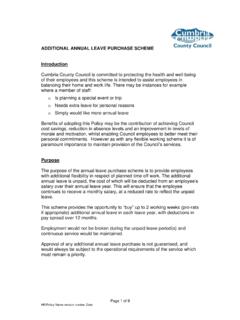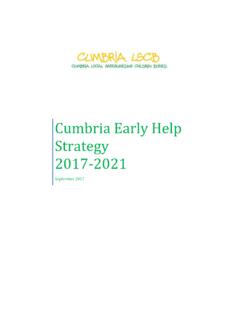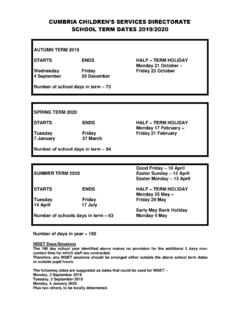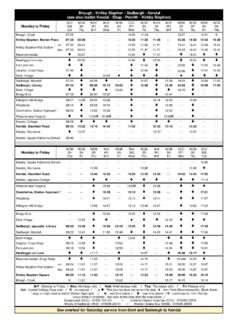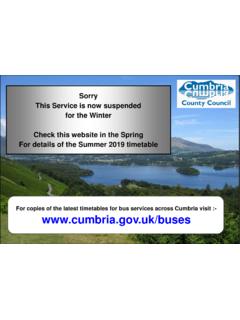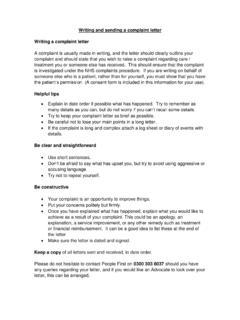Transcription of Multi-Agency Thresholds Guidance - Cumbria
1 Multi-Agency Thresholds GuidanceWe are working together to keep children and young people safe in 2016 Review Date: September 20182 Cumbria Local Safeguarding children BoardMulti- agency Thresholds What is the purpose of the Guidance ? How has the Guidance been developed? What does the Guidance include? How should the Guidance be used? Expectations Where do I go for more advice and Guidance ?52 The Wedge 63 children and young people in Our vision and aspirations84 Single agency Response85 Early Help106 Statutory Intervention 137 Step Up and Step Down 16 Appendix 118 Contacting Cumbria Safeguarding HubAppendix 220 RiskAppendix 322 Assessment Tools The Risk and Resilience Model and Matrix23-26 The Salford Graded Care Profile 28-57 LSCB Scaling tool - March 201558-59 Appendix 4 Case studies604 Cumbria Local Safeguarding children Board1 What is the purpose of the Guidance ?The Local Safeguarding children Board commissioned the review of this Guidance in order to support all professionals working with children and young people so that everyone is clear: that an early help assessment is, in all but urgent cases, the starting point in meeting a child s needs; that what should follow from this is a plan of work on a Multi-Agency basis which improves a situation and outcomes for a child at the earliest possible stage; a common language is used; about regulation and good practice; about individual responsibility when working with children , young people and families; about the responsibility of different agencies; and about the tools in place to support professionals in their How has the Guidance been developed?
2 The Guidance has been written by a wide range of professionals who have been involved in shaping the approach and are actively involved in delivering it. Representatives from Health agencies, Police, Third Sector Organisations, children s Centres, Schools and Cumbria County Council children s Services1 have provided advice and challenge to the developing Guidance and have contributed to the consultation What does the Guidance include?The Guidance describes the overarching approach taken in Cumbria to supporting young people and children (pre-birth up to 18 years) and their families and then explains the differ-ent elements of the approach in more Multi-Agency Guidance seeks to: describe levels of vulnerability and the appropriate response at differing levels; set out the principles that underpin the way we will work with children , young people and families; make clear the Thresholds for action/intervention and provide case studies that give real life examples of this; provide a description of the Cumbria Safeguarding Hub and how this works in supporting a Multi-Agency approach to working with children , young people and families when it is appropriate to use it.
3 And provide the necessary information to ensure that those children and young people identifiedas having additional needs receive timely intervention and have access to services to address How should the Guidance be used?The Guidance is a reference tool for professionals. It provides an overview of the approach and key aspects and therefore should be read alongside other relevant shared policies, procedures and Guidance which are signposted in this document or those from your own should apply your own professional judgement when using the Guidance as the lists and scenarios included here are not this document where we are referring to Cumbria County Council children s Services, this will read as children s Services. When we are referring to a collective of organisations involved this will read as children s Thresholds ExpectationsIt is the expectation of member organisations of the children s Trust Board and Local Safeguarding children Board that all professionals working with children , young people and families will work within this Guidance and pay full regard to the more detailed associated policies and procedures in place.
4 All organisations should ensure managers and staff have access to support when working with children and their Where do I go for more advice and Guidance ?All professionals work within their own agency s policies and procedures and all agencies share the LSCB Safeguarding policies and procedures. The Multi-Agency Cumbria Safeguarding Hub (0333 240 1727) is the first point of contact where concerns meet the threshold. The Cumbria Safeguarding Hub will make a decision regarding the most appropriatecourse of action. The Screening Team will provide support, consultation and advice if the concern does meet the required Local Safeguarding children Board2 The WedgeEarly Help Assessment completed when there is an emerging need or when needs decrease and the work can step of needLevel of support to meet needUniversal servicesUniversal services are available to all children and young people. The most easily identifiable universal services that children and families will access are primary health and agencyThis is the first level of intervention after universal services.
5 It is a single setting/single agency response based on a dialogue with the child/family. The needs of a child or young person can be met by additional support from one helpA professional seeking advice and input from other agencies in order to meet a child s unmet needs. Discussion would first take place with the child/family to identify needs and agree outcomes and actions. Early Help Assessment (EHA) and plan of work would be initiated at this stage. Intervention is aimed at preventing escalation to statutory interven-tion. Evidence of an Early Help Assessment and intervention will help support a referral for statutory intervention if required at a later InterventionThe highest level of Multi-Agency intervention. Statutory intervention takes place in response to complex needs, involving Multi-Agency specialists where the consequences of non-intervention could lead to serious harm. These children may be at risk of becominglooked after or subject to a Child Protection plan.
6 This level also includes children with severe disabilities or complex learning difficulties. Contact with the County Safeguarding Hub is child or young person has different needs and will need different support in order to ensure their needs are met and they meet their potential in life and thrive. The Wedge model onthis page describes three different levels of additional requirements and support that children ,young people and families within Cumbria might experience. Each separate level in the Wedgeis described in more detail in the Guidance to assist professionals in identifying and assessing where a child or young person lies on this spectrum and understanding the subsequent actions expected of them at each level in order to ensure that the child s needs are children and young people have access to a range of universal services provided in their communities. These services include schools, early years settings, health, housing, youth services, leisure facilities and services provided by voluntary increasingUniversal services106,000 children and young people in CumbriaEarly HelpStatutory InterventionSingleagency Needs decreasingMulti- agency Thresholds , some children have greater needs and may require additional support or support from more than one agency .
7 Where this is necessary, in Cumbria our expectation is that there is a focus on early help and prevention services in order to ensure that children , young people and their families receive the most appropriate support to meet their needs at the earliest opportunity. In summary, the three levels of need are: single agency response to meet need; early help: focussed plan led by team around the family statutory intervention; statutory supportOnly a small proportion of children and young people in the county will need statutory Local Safeguarding children Board3 children and Young People in Our vision and aspirationsOur vision is: We are working together to keep children and young people safe in Cumbria . Approximately 99,100 children and young people under the age of 18 years live in Cumbria . This is 20% of the total population in the area. (Source: Mid-2014 Population Estimates, ONS)Approximately of the local authority s children (aged 0-19 years) are living in poverty (Source: HMRC).
8 children and young people from minority ethnic groups account for 2% of all children living in the area, compared with 22% in the country as a whole. of statutory school aged pupils in Cumbria are from Non-White British ethnic groups (Black and Minority Ethnic groups), below the national average of (Source: January 2016 School Census). children and young people live in communities which range from isolated rural settlements and farms to market towns and larger urban conurbations. Of the county s population, live in rural areas, compared with of the population in England and Wales. (Source: Office for National Statistics, 2011). Cumbria has been developing an effective safeguarding board with strong partnership workingarrangements and this will continue to be built on and strengthened. Through the Board structure the LSCB provides the strategic and operational direction of safeguarding and continuous monitoring of performance in Cumbria .
9 The Board produces a three-year Business Plan and an Annual Report. Single agency ResponseThe single agency response is based on a dialogue with a child/family. The role of professionals working with this group of children is to promote a healthy lifestyle, increase their achievement and resilience thereby maximising their life chances. It is also about empowering families. Usually, these children will make good overall progress in all areas of their development by accessing universal services. Occasionally these children will develop some additional needs which can be addressed by your agency alone struggling to achieve educational targets, regular advice to support a single health issue, short term friendship/relationship issues. This level of professional intervention will usually be time limitedand will be delivered within a single agency key message from Professor Eileen Munro s recent review of child protection is of the vital role that professionals working in universal services have in the provision of early help.
10 It is a shared responsibility for all those working with children and young people and families in local (Munro, 2011).This principle is a key foundation of the Cumbria LSCB partnership Thresholds agency Response:A single agency response based on a dialogue with the child/familyExamples of presenting characteristics of areas of needChild s developmental needsThis will include physical and emotional health, learning and behavioural development, family and social relationships. Struggling to achieve expected targets at end of key stages. No barriers to learning, but may lack focus and or need additional curricular support. Good all round physical and mental health, achieving developmental milestones, but may need regular advice or support regarding a single health issue. Child feeling sad because of a bereavement or loss death of extended family member/friend, separation of parents, chronic illness in family. Behavioural needs young person who usually respects school and parental boundaries starts being late for school and staying out after home curfew.

